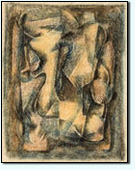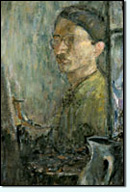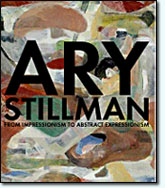Publications
Reminiscences > Ary in New York (1919)
By 1919, Ary felt that if he was to pursue his dreams of a painting career he must make for New York. His two younger brothers and his sister were able to find work, in addition to continuing with their schooling, and he had saved up enough money that his mother could receive a monthly sum and there would still be some capital for him to fall back on when necessary.

Ary as student at National
Academy of Design,
New York City
Ary dictated to me something of his first days in New York and I will quote this first of all.
"I came to New York from Sioux City and I had about $400 with me. It was Saturday evening. I walked on the East Side. Saturday night the street was very crowded—the banks crowded—the immigrants used to come around to get their mail, which was sent to them in care of the banks. There was one particular bank where all the "landsmen" would go. One man working there was a "landsman."
I passed by this bank and I said to myself, 'I am carrying money with me and it is so crowded down here, I'll go in and deposit it! I went into the bank; it was crowded and the guard told me to stand in line. I stood in line and waited until my turn came. I told the cashier I wanted to make a deposit of $400. The cashier said, 'We don't accept now. It's too late and we don't accept —we can't open an account. I was very much annoyed because I know there were people ahead of me attended to and why doesn't he want to take my money. No use in putting up an argument — I had to move on. So I walked away and I was terribly angry that I had to carry the money in my pocket.
"Monday morning I was surprised to hear that the bank had closed down. I always thought of that cashier who refused to accommodate me because it was too late.' Did he know and for some reason try to save me? It is difficult to determine whether he knew what was happening, and tried to save an innocent man's
In New York there was a distant relative I had known in Slutzk. The man who was supposed to meet me when I came over on the boat and forgot about it. He was one who had been in the ranks of the unemployed ever since he came over. His wife was a dressmaker. I went over to see him when I came to New York and I found that his lot had improved during the years when I was in Sioux City. I asked him if he knew where I could rent a room and his wife said that with her in the shop was a girl who lives on Lenox Avenue and they have a room for rent. She said they are very nice people and if I get a room there I will be all right. I went over. A very old lady let me in and she showed me a tiny little room squeezed in between the kitchen and dining room. It contained a folding bed, a tiny little table and a chair. In the corner were hangers to hang up my clothes. There was a window to a very dark passage. I asked the old lady how much it was. I was surprised at the low price that she quoted and I accepted, and the same afternoon moved in.
"I only stayed in that room when I was tired and had to go to bed, so I didn't record any cracks or spots in the wall. I was always very tired and would immediately fall asleep. I can only record that I remember sounds coming from the dining room and the voice of the old lady trying to quiet down any kind of discussion or argument so as not to disturb me. That little room was my home all the time I was in New York, until I went to Europe."
Ary used to talk often about the old lady and her family. She was a widow, with a large family of grown-up sons and daughters; a good-natured and hard-working woman and very kind to Ary. She was a hospitable soul, and the house was always over-flowing with the friends of the young people of the family. She would gladly have included Ary in all the noisy and happy gatherings, but Ary had not come to New York for this.
“Ary had to be there early in the morning to punch tickets during the breakfast hours. For this he received his breakfast and noon meal, and he was free to paint all day and evening. So during the day he painted at the Academy and evenings it was The Art Students League or the Jewish Educational Alliance.”
He enrolled at once at the National Academy of Design (now National Academy Museum and School of Fine Arts) and later at The Art Students League . Then he set out to look for work. He couldn't get a job in a jewelry store, because when they found out that he had been manager and a partner in stores in Sioux City, they said he wouldn’t be satisfied with the small jobs they had to offer. Finally in desperation he took a job as bus boy in a cafe on Broadway near Times Square. At one of the first tables he had to clear, there sat a man from Sioux City with his bride — a man to whom Ary had sold a wedding ring only a few weeks before. The man recognized Ary, and sensing Ary's embarrassment, introduced him to his wife, saying something about "these art students who work while they study." But after Ary carried the dishes out to the kitchen he took off his white jacket and left the cafe, never to come back. However he did find a cafeteria, up by Columbia University, which wasn't far from the Academy. It was patronized mostly by students, and run by two elderly spinsters. Ary had to be there early in the morning to punch tickets during the breakfast hours. For this he received his breakfast and noon meal, and he was free to paint all day and evening. So during the day he painted at the Academy and evenings it was The Art Students League or the Jewish Educational Alliance.
“Ary booked a cabin on a ship bound for France. Ary's landlady was disconsolate, for she had been hoping to capture him for one of her girls. But Ary was bent on painting, not romancing or marrying.”
In the summer Ary bought a camera, the kind that could make a print at once, and he would go to Coney Island or to a park in Brooklyn and take pictures of people there. He was skillful at grouping them to make an effective composition, and he could make quite a sum of money this way to help pay his rent and other expenses. He didn't enjoy this work however; some of the groups were tough and there were unpleasant experiences. So when he finally was on a boat going to Europe he took out his camera and in a sort of private ceremony he threw it into the sea, as a symbol of his deliverance.
The first summer he was in New York he spent some weeks on the estate of a very wealthy and prominent man, whose name I don't recall. This man had a big country estate in New Jersey, and he invited a number of art students from the Academy to come there and paint. They lived in a big barn; I don't know how they got their meals. The Soyers were among this group. Ary spent most of his time studying trees and how to paint them, which he said is a very difficult thing, for one doesn't paint separate leaves or branches, one has to paint them as part of a whole. I believe his success in painting trees derived from that time.
Meanwhile Ary's brother Eli had arrived in New York and was studying architecture at Pratt Institute in Brooklyn, while working as a conductor on a streetcar to make his expenses. Ary and Eli would get together whenever possible, and occasionally attended a concert together.
The second year in New York, Ary began to think about going to Europe. Joseph Raskin, a friend of his at the Academy, got a scholarship (Guggenheim, I believe) to study in Europe, and he, an art student named Ginsberg, and Ary booked a cabin together on a ship bound for France. Ary's landlady was disconsolate, for she had been hoping to capture him for one of her girls. But Ary was bent on painting, not romancing or marrying.
Copyright © 2002-2007 The Stillman-Lack Foundation.
All text and images on this site may not be published, broadcast, or distributed in any form without the prior written permission of The Stillman-Lack Foundation.




